 On Dasher! On Dancer!
On Dasher! On Dancer!
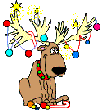
 On Dasher! On Dancer!
On Dasher! On Dancer!

| Reindeer, common name for a deer native to the subarctic and arctic regions of Europe and Asia. The antlers of the male are long, branched, and slightly flattened at the tips; the brow tines are well developed. The antlers of the female are smaller and simpler. | |
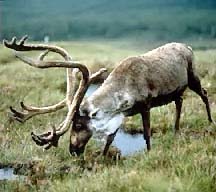 |
The reindeer inhabits the far northern reaches of Europe and Asia, as well as North America, where the animal is called a caribou. Although the population of reindeer has declined, some nomadic tribes in North Asia and Europe and northernmost North America still follow the herds, using the flesh of the animals as food and their antlers as tools and utensils. Massive assymetrical antlers grow on both male and female reindeer; the female reindeer is the only type of female deer to have antlers. |
| Reindeer are sturdy, short-legged animals, having a brownish coat that is dark in the summer and light in winter; the long hairs under the neck, the fur just above the hooves, and the region about the tail are almost white. Reindeer range in height from 87 to 140 cm (34 to 55 in) tall at the shoulder. The animals have large, spreading hooves that enable them to travel on snow-covered areas. They feed on vegetation such as grasses, leaves, mosses, and lichens, obtained by scraping away the snow cover with their antlers and hooves. | 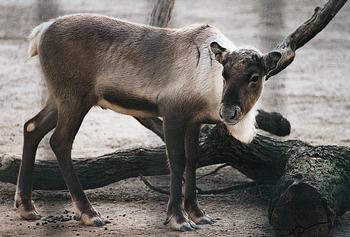 |
| For many centuries reindeer have been domesticated in their original habitat, which ranges from Norway into northern Asia. They have been trained to wear harnesses and draw sleds. In addition to their strength, speed, and endurance in pulling sleds over snow, they are also valuable for their milk, flesh, and hides. After they were introduced as economically valuable animals into Alaska in 1887, they thrived so well that they were later introduced into Labrador and northern Newfoundland. These North American forms of reindeer are called caribou. | |
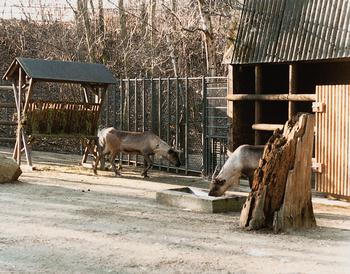 |
NENETS REINDEER PEOPLE
Deep in the Siberian wilderness, people live close to the land. Theirs is an economy of "natural" resources in every sense, subsisting as they do on the fish they catch, on the wild animals they hunt and trap, on the berries they collect and on the reindeer they raise. Travel to the back of beyond where you'll meet up with the Nenets reindeer herders, a people who are still living much as they did 500 years ago. Living with reindeer is not all Santa and elves. The Nenets live right off the land, even in this day and age. Theirs is an economy of "natural" resources in every sense, subsisting as they do on the fish they catch, on the wild animals they hunt and trap, on the berries they collect and on the reindeer they raise. Money is only needed to buy a few supplements such as flour, salt, sugar and tea. The Nenets are one of the largest of about 15 different reindeer-herding cultures scattered across the Russian Arctic. These people are still living lives very similar to those their ancestors lived as much as 500 years ago. During the Soviet era, all native peoples, many who barely knew the outside world existed, were forced into collective farms. Today, although all native children are educated outside the home, many have returned to their centuries-old traditions. |
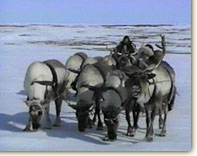 |
Scientific classification: The reindeer belongs to the family Cervidae of the order Artiodactyla. It is classified as Rangifer tarandus.
|
|
REINDEER LINKS: Reindeer and Caribou (Artic Studies Center)
The Totem people's Preservation Project |
 |
|
FACTS:
The reindeer ... is up to 2.2 metres long is the only kind of deer whose females also have antlers likes leaves, herbs, earth and tree lichens, mushrooms goes on long walks |
 |
|
The caribou, one of many species of reindeer, lives in the North American tundra. To reach their winter quarters from their summer quarters, caribous wander for more than 1,000 km, but not alone—the herds are often several thousand animals in size. When reindeers move through the country, they crackle really loudly. These rustling noises are caused by the movements of their tendons when they walk!
The largest antlers of all deers—at least in comparison to their body size—adorns the heads of the reindeers. And there is another special feature of these animals: female reindeers have got antlers, too. However, they are smaller than those of the male, and sometimes they are completely missing. Males are often loners—until mating time, which starts in autumn. Then they produce belling-grunting shouts to lure the females. Competing for the females, the males fight—even with their antlers. If they accidentally stick together while doing this, they cannot get apart from each other and have to starve. In the "reindeer-hunter-culture" of the Ice Age, the deer with its huge antlers played an important role as prey and art object. Already since the ninth century the Lapps in Scandinavia have kept the reindeer as a domestic animal. It provides their meat, fur for their clothes, and bones for their tools. Domestic reindeers are smaller than the wild ones, have got darker fur, and aren't as shy.
| |